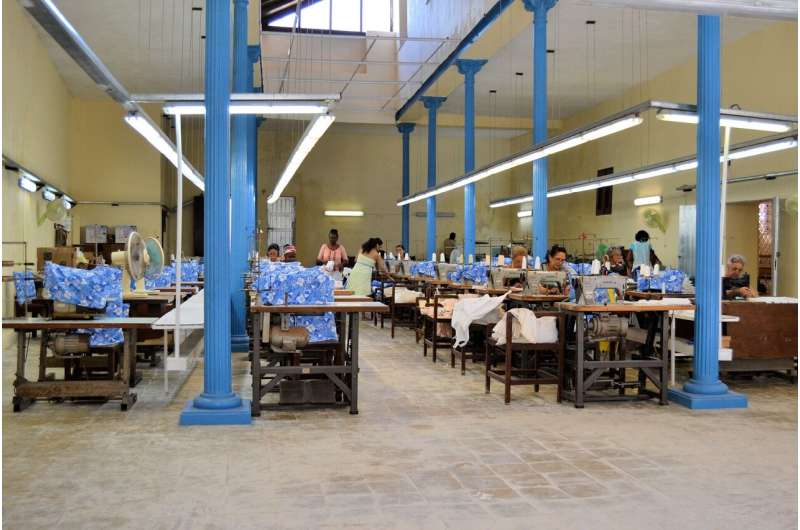This article has been reviewed according to Science X's editorial process and policies. Editors have highlighted the following attributes while ensuring the content's credibility:
fact-checked
trusted source
written by researcher(s)
proofread
Researcher: Debt, wage theft and coercion drive the global garment industry—the only answer is collective action

Major fashion brands including Barbour and PVH (the owner of Calvin Klein and Tommy Hilfiger) have agreed to pay over £400,000 in compensation to migrant workers in Mauritius. These workers from Bangladesh, India, China and Madagascar had been forced to pay illegal recruitment fees and, alongside other indicators of forced labor, were allegedly subject to deception and intimidation.
These are the findings from an investigation carried out between 2022 and 2023 by Transparentem, a US-based organization that investigates workers' rights.
Migrant workers across several Mauritian factories reported agreeing to pay fees ranging from a few hundred to several thousand US dollars to secure a good job. But, upon arrival, they discovered the job was poorly paid and expenses were higher than promised.
Exploitative practices like this are actually quite common. The Mauritius case is the latest example of the use of forced labor (the most commonly identified form of modern slavery) within company supply chains. But all garment workers—free and unfree—can experience unacceptable forms of exploitation that can only be countered through sustained labor organization.
The coloniality of our wardrobe
In 2013, an eight-story commercial building called Rana Plaza collapsed in Dhaka, Bangladesh. Over 1,100 people—mostly garment workers—lost their lives, leading to widespread protests and international scrutiny on working conditions in garment factories.
Since then, multiple reports have uncovered labor abuse in the garment sector, including several instances of forced labor.
A New York Times investigation found that Chinese companies were using Uyghurs to make personal protective equipment during the COVID pandemic through a contentious government-sponsored program. The Uyghurs are a largely Muslim, persecuted ethnic minority primarily from the Xinjiang region of north-west China.
The global emergency that was caused by the pandemic is over—at least for now. But new evidence suggests forced Uyghur labor remains present in 17 industries within China, including the garment industry.
Third-party labor contractors are also prevalent in many global supply chains. Contractors recruit and supply local or international migrant labor, and garment factories rely on them to manage and control their workforce.
But contract laborers are vulnerable to abuse. In the lower rungs of the supply chain (in informal workshops and homes), workers often work based on a system of advanced payments.
The labor contractor pays the worker an "advance," which locks the worker into their employment. It prevents them from negotiating better salaries or working for others until the debt is repaid.
In India, there is evidence that this debt-based system is spreading to garment factories. In Bengaluru, for instance, women in garment factories work under constant debt to their employer. Missed daily targets, lost productivity or time off are turned into debt that workers must compensate through future labor.
Many forced labor practices have a long history, dating back to colonial relations. Both labor contracting and indebtedness characterized the indenture labor system that dominated the production of textiles for centuries. In 19th-century India, for example, indenture workers were managed by labor contractors who paid them advances.
Under this point of view, the contemporary garment supply chain is a modern avatar of the colonial labor plantation.
Illegal terminations and wage theft
Not every worker that stitches our clothing is forced to do so. In fact, the majority are not. But even workers that we would consider to be "free"—those who are not tied to an employer or labor contractor—can experience harsh forms of exploitation.
I recently wrote a report for the International Labor Organization (ILO) with labor activist and colleague Rakhi Sehgal that documents some of the industrial grievances garment workers filed individually or via unions in India. The report is based on a project that contributes to the ILO's Work in Freedom program. This program aims to reduce vulnerability to forced labor in south Asia and the Middle East, particularly for women in the garment sector.
We analyzed a total of 75 grievances across three of India's export hubs—Gurugram, Bengaluru and Tiruppur—and found shocking patterns of labor abuse.
We discovered the widespread use of illegal terminations by employers, either through factory closures or relocation. We also found evidence of wage-theft. This usually involves not paying the worker's final wages—a practice that escalated during the COVID pandemic. But it can also be the result of managerial tactics like imposing impossible targets or paying overtime rates that are lower than the legal threshold.
Our report also highlighted gender differences in labor abuse. Sexual harassment was consistently deployed as a tool to discipline women working on the assembly line. We found widespread evidence of sexual harassment in Bengaluru, but it was also present in garment factories surrounding Delhi.
Social justice on the shopfloor
Cases like the labor abuse in Mauritius are conspicuous and show new connections between modern slavery and migration. But these cases are enabled by centuries of colonial and neo-colonial organization of production that has involved unacceptable forms of worker exploitation.
The analysis of the disputes in our study clearly suggests that social justice is only achievable through collective action. Most of the industrial grievances that were won by workers and their representatives were, unsurprisingly, collective grievances filed by unions.
In light of yet another sweatshop scandal, let us remember that upholding the freedom of association (the right to form and join trade unions) stands as the most effective means of fighting all forms of labor unfreedom—from Mauritius to India or Bangladesh.
Provided by The Conversation
This article is republished from The Conversation under a Creative Commons license. Read the original article.![]()




















